This article appears in the Fall 2023 Issue of Montessori Life Magazine. Read the full magazine online. (Members Only)
“Our children revealed to us a level of mind yet unexplored…. for instance, the children were never attracted to objects, such as toys, which were supposed to please them, nor were they interested in fairy tales.”
—Maria Montessori, The Child in the Family, p. 1
Many Montessorians uphold the belief that, for children, work is preferable to play, and that play, especially fantasy play, is antithetical to work. In recent years, children have experienced disruption to their social and emotional development as a result of COVID-19 lockdowns. Recent research suggests that play in a variety of forms is a natural antidote to this dysregulation. In this article, I review Montessori positions on play, look at research on the effects of social isolation, and advance the premise that “work needs play”: Children need to both work and play.
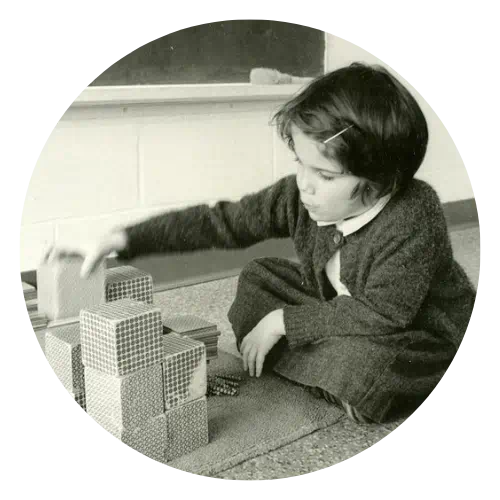
Montessori Legacy And Fidelity Practice
The benefits to children from their Montessori Early Childhood experiences occur most strongly, claims Lillard (2013), when Montessori programs adhere to authentic practice as originally taught by Montessori and then by her AMI successors. The benefits are academic and social, including the development of self-regulation (Lillard, 2012; Lillard & Else-Quest, 2006). According to the Montessori legacy and fidelity view of authentic Montessori, children should work and not play.
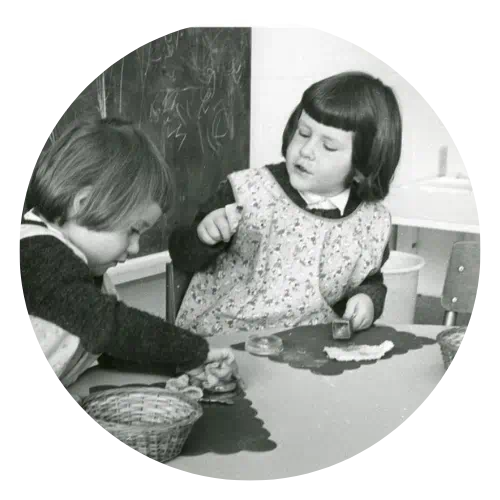
When children work, they concentrate. Montessori (1912) initially believed, however, that young children were incapable of concentration. Then the 1907 children of San Lorenzo concentrated, and their behavior changed. They experienced a conversion; they became self-disciplined (Montessori, 1966). The children preferred the Montessori materials, and they rejected toys (Montessori, 1912). In time, Montessori (1995) recognized concentration as “the whole basis for [the child’s] character and social behavior” (p. 222). The Montessori prepared environment and the Montessori materials were designed to assist children with self-development, and self-development occurred when children concentrated (Montessori, 1966, p. 139).
Although questioned recently (Lillard, 2020; Soundy, 2008), play, especially fantasy play, has little place in the Montessori legacy. Compared with work, play lacks internal purpose, and children develop their internal potential—their “level of mind”—when they work with the didactic materials (Montessori, 1989, p. 1; Montessori, 2012). Developed children are normalized children (Montessori, 2007). They have become who they are “meant to be” (Montessori, 2012, p. 216), and normalized children love to work (Futrell, 1997).
Given the circumstances of COVID-19, children’s development may have been significantly disrupted by the effects of extended periods of isolation due to closed schools, locked-down communities, and quarantined families required to stay indoors (Benner & Mistry, 2020; De Araújo et al., 2021). A number of studies and literature reviews recommend play as a remedy for the negative effects of months of isolation on children’s development, and submit that young children (between the ages of 2 and 8) returning to school after isolation need to first socialize and play for an extended period in order to then self-regulate and attend to academic lessons (Kourti et al., 2021; Prime et al., 2020; Nieto et al., 2021; Urbina-Garcia, 2020). The forms of play may include pretend, symbolic, and sociodramatic (Hughes, 2002).
These findings suggest that contrary to some of Montessori’s pronouncements, social skills such as self-regulation are developed during play, and these skills can be a foundation for concentration. In this paper, I suggest three paradigms with which to think about Montessori’s, and the Montessori Movement’s, beliefs about work, play, and fantasy:
- Paradigm 1: Work OR Play
- Paradigm 2: Work IS Play
- Paradigm 3: Work NEEDS Play
Paradigm 1:
Work OR Play
Montessori (1966) championed work as the process for how life self-constructs: “A child’s desire to work represents a vital instinct since he cannot organize his personality without working: a man builds himself through working. There can be no substitute for work, neither affection nor physical well-being can replace it” (p. 186).
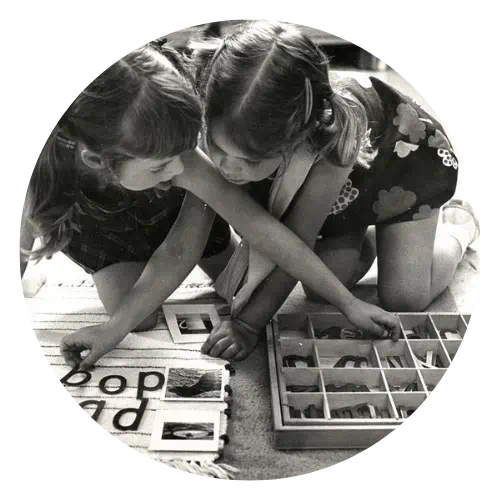
For Montessori (1995), work has noble purpose: “If the work of man on the earth is related to his spirit, to his creative intelligence, then his spirit and his intelligence must be the fulcrum of his existence, and of all the workings of his body” (p. 56). Work with concentration is the basis from which children develop socially (Montessori, 1995). Montessori’s student E. M. Standing (1957) described the necessity for work with concentration:
The aim of the child’s work is not external but internal. He works in order to grow. You cannot therefore see visibly the end for which he is expending all these labours. It is something remote, hidden in the obscurity of the future. Indefatigably, irresistibly, unceasingly, joyfully, the child is working to create the adult, the man-that-is-to-be. (pp. 142–143)
Children are meant to concentrate when they work with the didactic materials. Montessori guides observe children and, if necessary, redirect them should they “misuse” the materials. Consider this: We observe a child working with a Practical Life pouring exercise. She does not speak while repeating and pouring 10 times. We were taught, and we teach new adult learners, to interpret her repetitions and silence as work with concentration. Later, we observe a second child with the same Practical Life pouring exercise. After the 10th pour, this child turns to a child next to her and asks, “Do you want a water pizza?” Does her question suggest her activity was imaginative play even though she had poured, repeatedly and silently? And how can we be certain about our conclusion that the first child, silent while pouring and “working” (our label), was not imagining a water pizza?
Similar moments occur when children use the Sensorial materials. For example, children work and concentrate as they arrange cubes of the Pink Tower or sort lengths of the Red Rods. When a child uses these materials, she learns to observe and to “make comparisons between objects, to form judgments, to reason and to decide; and it is in the indefinite repetition of this exercise of attention and of intelligence that a real development ensues” (Montessori, 1914, p. 33).
But what differentiates work from play? For Montessori (2012), work has internal purpose; play does not and, as I have observed and heard from other educators, may constitute a misuse of the material. But do concentration and internal purpose occur only and exclusively when working? Children also use the Sensorial materials and build houses, trains, rockets, and other pretend constructions. They do this with immense concentration, but we call this play. If children concentrate when they play, do they concentrate in the same way as when they work?

Throughout her life, Montessori met opposition from educational leaders (especially those who championed play), psychologists, and political leaders (De Stefano, 2020). Her schools competed with educational leaders and followers of Fröbel (1826) and the kindergarten movement who championed play as the proper developmental activity of young children. In the United States, Kirkpatrick (1914) strongly objected to the Montessori Movement and defended both John Dewey’s democratic system of education and play. Is it possible Montessori countered with work to differentiate her brand?
Absent from Europe during the Second World War, Montessori returned to find play was still very much in vogue in early education. In 1946, Montessori (2012, p. 145) announced her own interest in play:
All children play. Of course, I don’t know all languages, but I believe there must be a word for play in every language. All children, everywhere, play together. We must look at this play from a new point of view.
That “new point of view” did not emerge in Montessori’s writings, and she (2012, p. 16) continued to maintain that children preferred to work and not play with toys:
The hand is the instrument of the intelligence. The child needs to manipulate objects and to gain experience by touching and handling. There is an age when children play; we call it the age of play. But what is play if not to do those things which entail the movement of the hands? Children need to touch, to move all the things which they find in the environment. Today children are given toys; that at least is something. Even if they are not fundamentally the right things, at least they fulfill the need for manipulation. However, when I gave the children this scientific material, they preferred it to toys because it responds to an urge in their nature; it enables them to develop.
Montessori defined play as activity that involves “those things which entail the movement of the hands.” This is also her description of children’s activities when they work. Was she rendering work synonymous with play here? Still, Montessori continued to argue that the best things were her scientific materials and not toys. She observed children working with her materials and noted children “refused to take the toys and waste their time in playing and making those friendly gestures to their little companions.” She concluded, “The thought struck me that through some human instinct children would rather acquire knowledge than be engaged in senseless play, and I reflected on the grandeur of the human mind. I therefore put away the toys” (1967, p. 232).
In other of Montessori’s writings, work and play are not synonymous. Work, according to Montessori, is purposeful; play is not. Work is a human tendency; play is not (Miller, 2020; Montessori, M. M., n.d.). Children construct their personalities and develop their potentials when they work. Montessori (2012, p. 155) warned that children will develop a “wandering mind” when they play:
When the child does work which has no external purpose, we call it play. We must realize the child’s inner purpose and that this unification of the personality is only possible at this age. If nothing is done to stimulate this, the person will end up with a wandering mind, incapable of finishing anything, capricious, weak, unhappy, unsatisfied, agitated—he will have no unity.
Fantasy is even more dangerous:
[There] are children who…live in a world of fantasy. They do not live in the real environment, but in their own ideas. Their movements are disorderly because they move without purpose and because they lack mental order. These children are [impulsive], liars, and dishonest. Very vivacious children rush around and break everything. They play with things on the floor, and they go off to something else, leaving their things lying about. (Montessori, 2012, p. 140)
Work is the remedy to the dangers of play. The prepared environment must offer children opportunity to “awaken the sleeping soul and give it life” (Montessori, 2012, p. 140).
Paradigm 2:
Work IS Play
Montessori’s own writings notwithstanding, some Montessori educators propose that Montessori did regard work and play as synonymous in purpose, especially when it came to playful learning. The work/play dichotomy is false because work is play (Flores Shaw, 2015). Instead of some activity being work and some activity being play, activity should be understood as work/play. Lillard (2013) asserts Montessori thought work is play, and play is work, unless children play pretending or engage in fantasy play (Lillard & Taggart, 2018). According to Lillard (2020), when children engage in play-based learning, they “play with hands-on materials in order to learn academic content. In this sense, Montessori education is play” (p. 2). In a similar assertion, Liu et al. (2017) declared that normalization fits the description of play-based learning.

When work and play are synonymous, we can understand and describe children’s activities as “work is play.” Children play—which is work—when, for example, they use a cylinder block:
Children play with the set of cylinders…. After the teacher presents the task, children are free to play with the Wooden Cylinders on their own. Through this work, three-year-olds focus on dimensional concepts they will later apply in formal mathematics (width, height, volume). (Lillard, 2013, p. 144, emphasis added)
“Play” is now substituted for “work,” and Montessori’s scientific pedagogy is still intact. Accordingly, when children engage in play-based learning, they choose activities according to their interests. Children are intrinsically motivated to play, to learn. Children may also choose to play alone or with peers and for as long as they wish. Teachers observe and follow children’s playful interests. They provide guided learning during the play period with their lessons and by modifying the play-based learning activities and the learning environment itself.
Proponents of “work is play” do note several differences between play-based learning in the Montessori environment and play-based learning in non-Montessori environments (Lillard, 2013). Work is, in other words, “somewhat” like play. The Montessori materials are more structured, and both the numbers of materials and objects that make up each material are more limited. For example, there is only one Pink Tower, made up of exactly 10 cubes. By comparison, a set of wooden blocks has both many more blocks and shapes. There are also more restrictions (“freedom within limits”) with the use of the Montessori materials. Children are required first to have a presentation with a material and are meant to use the presented materials for their intended purposes. The Montessori materials do not offer children many opportunities to freely define the purposes of the objects, unlike unstructured building blocks with which children can build pretend houses, airplanes, or zoos. The Pink Tower is not, for example, a rocket. Pretend, fantasy, and symbolic play is thought to interfere with what children should be learning from a didactic material.
Paradigm 3:
Work NEEDS Play
If work is “somewhat” like play, then children benefit from engaging in both work and play. The combined differences between the two activities should offer children a greater holistic development. The value of play is especially identified by research concerning the effects of COVID-19 on socio-emotional development in young children. These studies highlight the necessity for play and all its forms, including pretending and fantasy. Contrary to the Montessori belief that work with concentration is the foundation for young children’s social development, play may develop children’s abilities to concentrate. When children play, they also learn to understand their roles and the roles of others in a group, and they learn to coordinate behaviors needed to socially construct the group (Cameron & Tenenbaum, 2021). Play can improve mental health and well-being, strengthen positive parent-child interactions, build children’s confidence, and protect children from lengthy exposure to stress (Nieto et al., 2021).

Hughes (2002) identified 16 types of play children use to learn how to socially construct and understand their world. Sticks become horses (fantasy, symbolic play). Children play mother, father, baby, and dog; they play adult work, shopping, and cooking (sociodramatic play). During play, children invent the perspectives of their pretend roles (social play); they play their understandings of how mom (or dad, baby, or dog) see and act (role-play). Children engage in pretend play and develop cognitive processes such as divergent thinking, idea generation, symbolism, and imaginative storytelling. Children play and develop their abilities to create, solve problems, and make decisions. When children play, they communicate, share, and collaborate. They express what they like and do not like; they express their interests (Hoffman & Russ, 2012). Hughes also identified that play occurs digitally, with apps and with Zoom screens, tablets, and smartphones (Marsh et al., 2016).
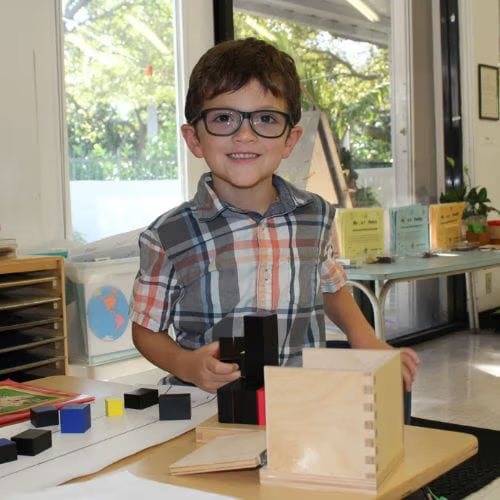
Some research concerning the effects of children’s isolation due to city lockdowns and school closings during COVID both describes children’s developmental delays and predicts long-lasting effects on children’s development (Benner & Mistry, 2020; Prime et al., 2020). These delays and long-lasting effects are thought to occur because consistent and predictable home and school routines, necessary for typical development during early childhood, were disrupted (Tan et al., 2022). Children were not able to establish the security and trust needed for typical development (Isaacs, 2013; Sytsma et al., 2001). Changes in home routines during COVID lockdowns resulted in sleep difficulties and excessive screen time. Screens became surrogate caregivers for parents trying to balance their work needs and their children’s needs. Isolation during COVID also increased stress levels of parents and caregivers (Sonnenschein & Stites, 2021). In addition, children were unable to develop their abilities to regulate emotional and social skills, such as empathy, that are needed to establish and maintain meaningful relationships (Urbina-Garcia, 2020).
Egan et al. (2021) surveyed 506 Irish parents of children aged 1 to 10 about their experiences during school closings. These parents reported increased incidents of their children’s tantrums, anxiety, clinginess, boredom, and under-stimulation. Parents also described their children as lonely, isolated, and lacking interaction. Their children missed play activities, friends, teachers, and caregivers. Some parents, however, did report positive aspects for their children during school closings: There was more time for play with siblings.
Similar findings were reported by Tan et al. (2022) who surveyed 130 Chinese parents of preschool-age children to examine the effects of 76 days of lockdown in the city of Wuhan between January and April 2020. Parents were asked to describe changes in their children’s daily learning time, screen time, play and exercise, and nighttime sleep before, during, and after the lockdown. The authors concluded that “decreases in play and exercise time [were] related to less child-parent closeness, and decreases in learning time and increases in nighttime sleep [were] related to more child-parent conflict” (p. 10). (The increase in nighttime sleep was, the researchers reported, a result of lockdown-related stress.) They found, in other words, that stressful changes in children’s daily routines due to isolation during an extensive lockdown period negatively affected children’s development and the quality of their relationships with their parents. Parents reported their children’s and family’s routines returned to “normal” some three months after the Wuhan lockdown ended. Tan et al. (2022) concluded that they cannot know what, if any, long-term impact this had on the children’s development.
De Araújo et al. (2021) reviewed and summarized published research on COVID-19 isolation. These authors defined optimal children’s growth and development to include both positive family experiences and high-quality school experiences. These experiences prevent toxic stress and are necessary for “the development of strong and lasting neural connections in the child’s brain” (p. 373). De Araújo et al. (2021) concluded that isolation during COVID changed the “construction and structuring of the child’s brain architecture” (p. 373): “[There] is a tendency towards limitations in the formation of certain areas of the brain, including the social brain, with consequent impairment in the acquisition of cognitive, behavioral, social, and communication skills” (p. 374).
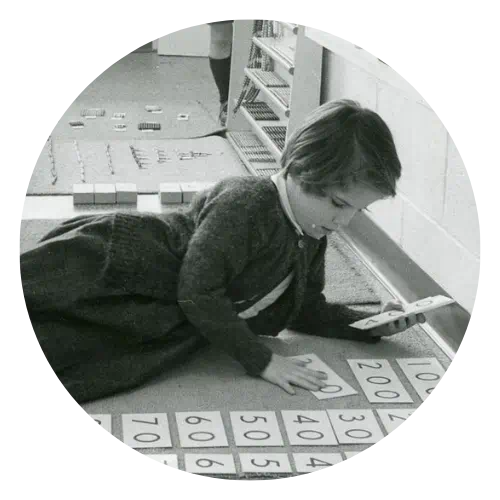

Beneficial Play
Play may be a natural antidote to negative developmental effects accrued from isolation during COVID-19 lockdowns. Isolation has disrupted daily routines with predictability and order, affecting the development of self-regulating behavior. Benefits of play include learning to cooperate and work together. Children also learn to express their ideas and listen to the ideas of others (Singer et al., 2006). Overall, children improve their cognitive abilities and reduce anxiety when they play (Kourti et al., 2021). When children play, they also develop socially and emotionally:
[Play] sets the foundation for the development of critical social and emotional knowledge and skills. Through play, children learn to forge connections with others, and to share, negotiate and resolve conflicts, as well as learn self-advocacy skills. Play also teaches children leadership as well as group skills. (UNICEF, 2020, p. 10)
Play became a method for reintroducing children into their Montessori environments after the lockdown and isolation of COVID-19. In June 2022, I had a conversation with nine Chinese Montessori teachers, working in different Early Childhood environments. I asked them to describe the children’s return to school after months of absences and isolation due to COVID disruptions. The teachers also interviewed some of their parents and asked them about changes in their children’s sleep routines, screen time, and quality of time with parents during the city’s lockdown. (It’s worth noting that lockdowns in parts of China were more restrictive than in other parts of the world; often, people were not able to leave their homes, while others were only able to leave to go to centralized checkpoints to pick up necessary items like food.)
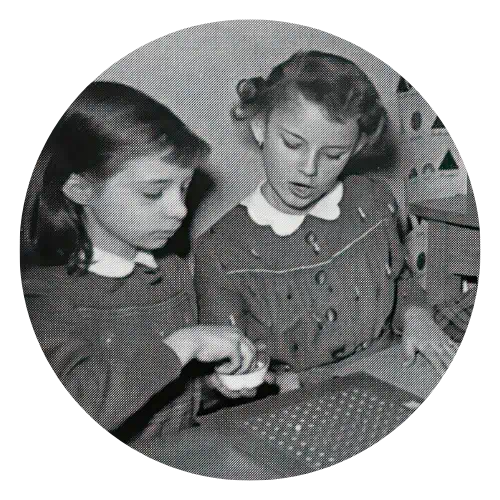
These teachers stated most of the children were cared for by ayis (a hired adult who cares for children and performs other household duties) during isolation/lockdown while their parents tried to work from home. While some children and their families were able to go out to parks, most of the children could not leave home. During the isolation period, the teachers held online learning activities with the children. These teachers concluded, however, that these sessions were not effective. The young children could not focus on the activities, which included singing songs, listening to stories, and demonstrating learning activities.
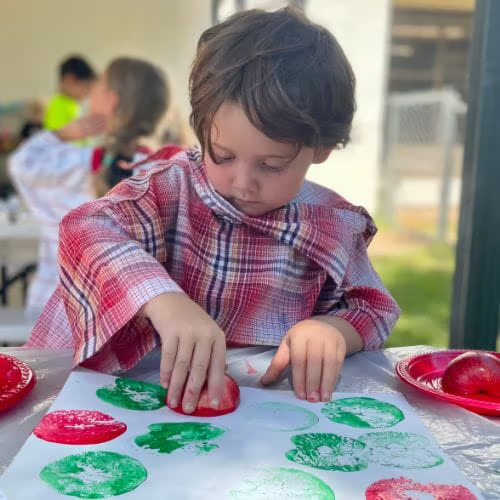
These teachers asked some of the children’s parents about the effects of isolation and routine disruption. Parents described their children’s sleep patterns as erratic; children either slept very late or awoke too early. Use of screens increased; children could not go outside, and they tired of their toys. Rooms at home became messy. Parents who worked at home during the pandemic described experiencing greater stress as they tried to balance their work requirements with their children’s needs for their undivided attention. For example, their children acted out during video work calls. When parents cannot listen well to their children, their children may not feel safe or secure; they may not feel understood, loved, and valued (Urbina-Garcia, 2020). On the other hand, parents who did not work during isolation described improvements in their relationships with their children. These parents enjoyed more connections and getting to know their children.
After the pandemic, and as children began to play together again in their neighborhoods and at school, parents described their children as happier. Children had less screen time. Sleep became more regular. When the children returned to school, the nine teachers I spoke with observed quickly that their environments were not prepared; their environments, filled with Montessori materials, were too stimulating. The teachers said the children responded to the environments as if they had never been to school before. They had forgotten each other, how to make choices, and the classroom ground rules. One teacher summarized the effects of isolation on the children in his environment: “At first it was as if they had lost their souls.” The teachers described how they simplified their environments, removing many Montessori materials and instead offering children familiar play choices, such as blocks, puzzles, and “simple art activities.” But the work children most preferred was each other; for almost 2 months, they played together. The teachers then observed that children began to choose individual work, and they began again to concentrate.
The benefits of play these teachers describe, including cognitive resilience and greater happiness, echo research findings from the pandemic, even though in many cases the nature and amount of play changed. Kourti et al. (2021) reviewed 17 published studies on the effects of isolation on play during COVID-19. These studies involved children and their parents living in Europe and North America. The nature of play and its benefits changed during COVID. In the absence of peers, opportunities for social play were significantly reduced. Children played alone, with siblings, or with their parents. Children built cognitive resilience when they played, and play also functioned to reduce children’s stress. The forms of the children’s play described in the reviewed studies included pretend role-play and fantasy play. Children role-played, for example, “COVID”: They pretended to be doctors and gave medications to pretend patients. It is worth noting that during lockdown restrictions, opportunities for outdoor play were severely limited and indoor play time was also disrupted by screen time, which does not fall under the category of “play” used in this paper. Time for play, and its benefits, decreased significantly when children were with screens, including television, videogames, smartphones, and tablets.
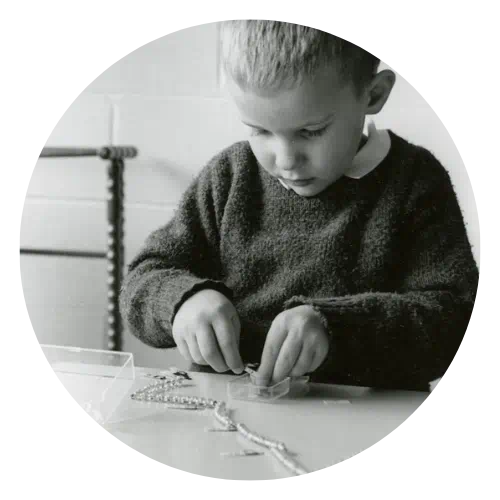
Summary
Montessori’s (1912) first one-room schools enrolled children who lived in adverse, stressful conditions. However, these children were not socially isolated, and they rejected play with dolls and toys, preferring to work with the didactic materials. While many parents, educators, researchers, and politicians embraced the Montessori Method, many did not. They objected to work and insisted that children develop best when they play. Some Montessorians today argue that Montessori would recognize work as play. Playful learning, for example, is described as resembling Montessori’s descriptions of work (Lillard, 2013). While we cannot know how Montessori would view modern interpretations of her work, research concerning the negative effects of isolation on children during COVID-19 lockdowns suggests children need play in all its forms for social development and self-regulation. Accordingly, Montessori guides should augment their prepared environments and offer children opportunities for all types of play.
Photos Courtesy
- Alexander Montessori School, Miami, FL
- Evergreen School, Silver Spring, MD
- The Montessori Academy Of Arlington, Arlington, TX
- Montistory (facebook.com/montistory)
- Redeemer Montessori School, Irving, TX
- UCONN Library Archives & Special Collections
- Westside Montessori School, Houston, TX
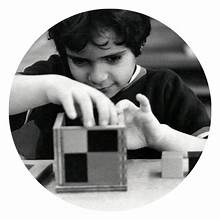
References
Benner, A. D., & Mistry, R. S. (2020). Child development during the COVID-19 pandemic through a life course theory lens. Child Development Perspectives 14(4), 236–243.
Cameron, L., & Tenenbaum, H. R. (2021). Lessons from developmental science to mitigate the effects of the COVID-19 restrictions and social development. Group Processes & Intergroup Relations 24(2), 231–236.
De Araújo, L. A., Veloso, C. F., de Campos Souza, M., de Azevedo, M. C., & Tarro, G. (2021). The potential impact of the COVID-19 pandemic on child growth and development: A systematic review. Journal de Pediatria.
De Stefano, C. (2020). The child is the teacher: A life of Maria Montessori. Other Press.
Egan, S. M., Pope, J., Molomey, M., Hoyne, C., & Betty, C. (2021). Missing early education and care during the pandemic: The socio-emotional impact of the COVID-19 crisis on young children. Early Childhood Education Journal, 49(5), 925–934. https://doi.org/10.1007/s10643-021-01193-2
Flores Shaw, L. (2015). Montessori and play. The Montessori White Papers 2 (pp. 1–8).
Fröbel, F. (1826). The education of man. D. Appleton and Co.
Futrell, K. H. (1997). The normalized child. NAMTA Journal, 22(2), 138–156.
Hoffman, J., & Russ, S. (2012). Pretend play, creativity, and emotional regulation in children. Psychology of Aesthetics, Creativity, and the Arts, 6(2), 175–184.
Hughes, B. (2002). A Playworker’s Taxonomy of Play Types (2nd ed.). Playlink.
Isaacs, S. (2013). Social development in young children (Vol. 20). Routledge.
Kirkpatrick, W. H. (1914). The Montessori system examined. University of California Libraries.
Kourti, A., Stavridou, A., Panagoulis, E., Psaltopoulou, T., Tsolia, M., Sergentanis, T. N., & Tsitsika, A. (2021). Play behaviors in children during the COVID-19 pandemic: A review of the literature. Children, 8, 706–724.
Lillard, A. S. (2012). Preschool children’s development in classic Montessori, supplemented Montessori, and conventional programs. Journal of School Psychology, 50(3), 379–401. https://doi.org/10.1016/j.jsp.2012.01.001
Lillard, A. S. (2013). Playful learning and Montessori education. NAMTA Journal, 38(2), 137–174.
Lillard, A. S. (2020). Montessori as an alternative early childhood education. Early Child Development and Care, 191(7–8), 1196–1206.
Lillard, A. S., & Else-Quest, N. (2006). The early years: Evaluating Montessori education. Science, 313(5795), 1893–1894. https://doi.org/10.1126/science.1132362
Lillard, A. S., & Taggart, J. (2018). Pretend play and fantasy: What if Montessori was right? Child Development Perspectives, 13(2), 85–90. https://doi.org/10.1111/cdep.12314
Liu, F., Choy, C., & Tsang, P. (2017). “Play is the work of the child”: Montessori and play-based learning. Hong Kong Montessori Research and Development Association.
Marsh, J., Plowman, L., Yamada-Rice, D., Bishop, J., & Scott, F. (2016). Digital play: A new classification. Early Years, 36(3), 242–253.
Miller, D. F. (2020). Review of “The Human Tendencies and Montessori Education” by Mario Montessori. Personal communication with author.
Montessori, M. (1912). The Montessori method. Frederick A. Stokes Co.
Montessori, M. (1914). Dr. Montessori’s own handbook. Frederick A. Stokes Co.
Montessori, M. (1966). The secret of childhood. Ballantine Books.
Montessori, M. (1967). The discovery of the child. Ballantine Books.
Montessori, M. (1989). The child in the family. Clio Press.
Montessori, M. (1995). The absorbent mind. Holt Paperbacks.
Montessori, M. (2007). The formation of man. Clio Press.
Montessori, M. (2012). The 1946 London lectures. Montessori-Pierson Publishing Co.
Montessori, M. M. (n.d.). The human tendencies and Montessori education (2nd ed.). Association Montessori Internationale.
Nieto, A., Redinger, S., Mitter, R., Elliot, M., Solis, L., & Popp, J. (2021). The power of play in the pandemic. UNICEF. https://blogs.unicef.org/evidencefor-action/the-power-of-play-in-the-pandemic/
Prime, H., Wade, M., & Browne, D. T. (2020). Risk and resilience in family well-being during the COVID-19 pandemic. The American Psychologist, 75(5), 631–643. https://doi.org/10.1037/amp0000660
Singer, D. G., Golinkoff, R. M., & Hirsh-Pasek, K. (Eds.). (2006). Play = learning: How play motivates and enhances children’s cognitive and social-emotional growth. Oxford University Press.
Sonnenschein, S., & Stites, M. L. (2021). The effects of COVID-19 on young children and their activities at home. Early Education and Development, 32(6), 789–793. https://doi.org/10.1080/10409289.2021.1953311
Soundy, C. S. (2008). Young children’s imaginative play: Is it valued in Montessori classrooms? Early Childhood Education Journal, 36(5), 381–383. https://doi.org/10.1007/s10643-008-0282-z
Standing, E. M. (1957). Maria Montessori: Her life and work. Hollis & Carter.
Sytsma, S. E., Kelley, M. L., & Wymer, J. H. (2001). Development and initial validation of the child routines inventory. Journal of Psychopathology and Behavioral Assessment, 23(4), 241–251. https://doi.org/10.1023/A:1012727419873
Tan, T. X., Wang, J. H., Wang, P., & Huang, Y. (2022). Child-parent relationship during the Wuhan COVID-19 lockdown: Role of changes in preschool children’s daily routines. Family Relations: Interdisciplinary Journal of Applied Family Science, 72(1), 92–104. https://doi.org/10.1111/fare.12755
UNICEF. (2020). Early childhood development and COVID-19. https://data.unicef.org/topic/early-childhood-development/covid-19/
Urbina-Garcia, A. (2020). Young children’s mental health: Impact of social isolation during the COVID-19 lockdown and effective strategies. PsyArXiv Preprints. https://doi.org/10.31234/osf.io/g549x


